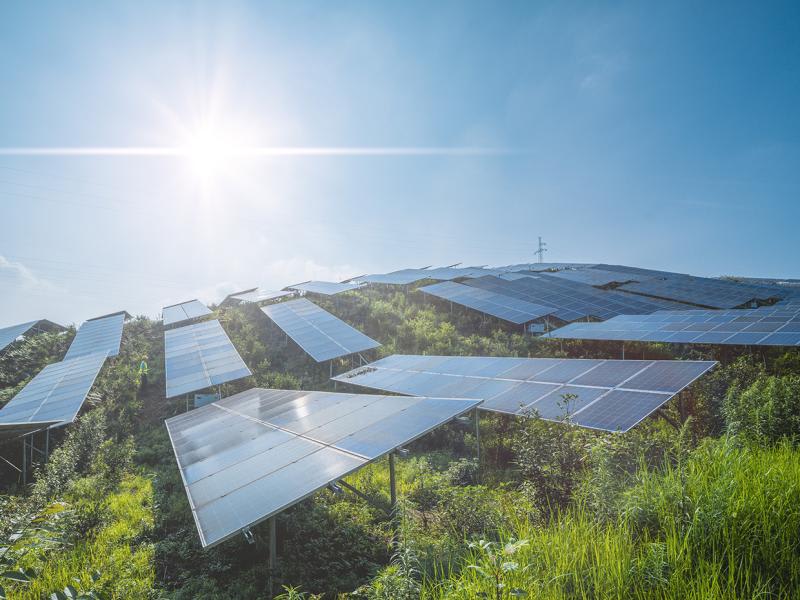AUTHOR
Australia will need new strategies, partnerships and funding models if it wants in on the green transition.
Australia’s electric dream is charging up, set to revolutionise our infrastructure like nothing witnessed in modern times.
However, the complexity, cost and growing competition in this space means that new strategies, innovative partnerships and funding models will need to be developed if Australia wants a piece of the pie.
In November 2023, Federal Treasurer Jim Chalmers directed the new head of the Productivity Commission, incoming chair Danielle Wood, to prioritise climate change and technology to support an (as yet) undefined cross-government energy policy, as part of the first ever statement of expectations for the independent commission.
And shortly after at the Energy Transition Conference, WA Premier Roger Cook declared that Western Australia is to become a renewable energy powerhouse and a key green energy partner to Asia, having committed funds and resources to realise this ambition, albeit with a significant carbon footprint to execute which does not align with some protagonists, and it may have other unintended consequences, too.
At the heart of this green transition lies the powerhouses of clean energy: solar, wind turbines, and battery storage. As the essential building blocks of a sustainable future, conversations are increasingly turning to the materials needed to bring them to life.
"Critical minerals" will take centre stage due to their criticality in producing many of the components required for Australia (and the world) to meet its net-zero targets.
With our rich deposits and advanced mining sector, our country is well equipped to satisfy not only domestic demand for critical minerals but international demand as well. It’s an unprecedented opportunity for Australia to grow its capability in more than just extraction and exportation, and become a manufacturing hub where mineral processing takes place in the vicinity of mining sites.
In addition to reducing the carbon footprint associated with exporting, this vision of a self-sufficient greener future could place Australia at the forefront of the renewable energy revolution.
Spearheading critical minerals research and development
Maximising Australia’s critical mineral assets and unearthing the full potential of domestic processing will take a collaborative effort between government and industry.
The Future Battery Industries Cooperative Research Centre (FBICRC) is leading the charge in this area with a focus on expanding the national battery industry and, in particular, capitalising on the raw materials related to battery production (such as lithium, nickel, and cobalt). The initiative unites industry, academia and government to drive innovation and research in battery technologies, and create a stronghold for Australia as demand for electric vehicles and renewable energy storage solutions increases.
FBICRC chief executive Shannon O’Rourke says the growing number of announcements about new refineries, materials production facilities, and battery manufacturing businesses are already proving that Australia is an attractive investment destination.
“Globally, there’s a lot going on,” Mr O’Rourke said.
“There is international competition to capture industry and the race is on to attract global leaders like BASF, Panasonic, LG Chem, Tianqi, Samsung, Posco, and others. The combination of increased commodity prices, demand, advancements in electric vehicles, and government subsidies is doubling the opportunity.
“Australia is the only nation in the world with large resources of all the required critical minerals. Not just one mineral, but all of them. We are also the only location with the minerals, cheap energy, and industrial infrastructure to vertically integrate our domestic production and compete with China.”
Mr O’Rourke notes that Australia is cost competitive across the entire value chain, including being:
- 28% cheaper than Indonesia for lithium refining
- 8% cheaper than Indonesia to produce advanced materials
- 5-8% cheaper than the United States to produce battery cells and packs
“Bloomberg reported that Australia has the largest pipeline of energy storage projects behind China, and a recent SunWiz report shows that our behind-the-meter battery storage market is already up 55% year on year,” he adds
“Our battery manufacturing industry is growing too with multiple refinery, materials, cell, pack and system manufacturing projects operating and in development. Given the interest, our own forecasts for battery demand have increased 64%. Forecasts for battery prices are up 35%, driven by global government spending on clean energy which has also increased 30% over the last two years. 
“Our ‘Charging Ahead’ report reveals an amazing battery industry opportunity for Australia – one that could add $55.2bn in GDP and 61,400 jobs by 2030. By the end of 2024 financial year, we are on track to earn up to $15bn from lithium exports alone.”
The FBICRC manages a database of battery industry-related projects across the country, and estimates there are approximately 180 projects underway or in development in WA in areas spanning cells, mines, materials, green energy production, big batteries, modules, recycling, refineries, research and technology.
Mining-related projects make up approximately half of all project activity, and new developments are continuing in many other areas of battery production.
To help spur the momentum, the Australian Government has allocated $5 billion to the sector in recent years and implemented three policy mechanisms to help Australia compete on the global stage, including:
- Australia’s National Reconstruction Fund (NRF)
- the Critical Minerals Strategy
- the National Battery Strategy
“The NRF is a gamechanger for Australia,” Mr O’Rourke said.
“It’s modelled on the CEFC [Clean Energy Finance Corporation], which receives $2.30 in private capital for every $1 in government capital. This implies that the $15 billion NRF could deliver a $50 billion capital pipeline.
“Through these three key policy measures, Australia is making responsible and ambitious steps to rebuild its manufacturing base.”
The feasibility of local critical mineral processing
Wood, a global consulting and engineering firm specialising in the energy and materials markets, has extensive experience in battery mineral processing. It has worked on key projects and studies within the critical minerals industry in Australia and abroad – from the IGO downstream nickel refinery to the Blackstone Minerals Ta Khoa project, AVL Vanadium processing plant, EVM Battery Chemicals Complex, Albemarle Kemerton Lithium plant, Iluka Eneabba project, and more.
Wood (in partnership with IGO) developed a new direct crystallization (DXTL) method of producing nickel sulphate crystals from a solvent extraction circuit without the use of an evaporative crystallization circuit. The new technology significantly reduces CAPEX to produce the battery grade metal salt, nickel sulphate, in contrast to the traditional approach. Energy use was reduced by >90% using DXTL versus traditional methods.
“Companies engage us to design manufacturing plants for them as we understand the challenges involved in setting up these operations in Australia,” Wood lead process engineer Ryan Harrison said. “We have done a lot of work in the production of precious metals over the years, and have definitely seen a shift towards battery minerals more recently.
“It’s exciting as Australia has a lot in its favour in this space – from raw materials to a highly skilled mining workforce. "
Currently as part of the FBICRC there is a precursor Cathode Active Material [pCAM] pilot plant in operation. This is a step between producing pure metal salts and battery manufacturing, and is essential in manufacturing lithium-ion batteries.
“We already have plants that produce pure metal salts, which is midstream processing, so we’re close. The further we can go in the production chain, the better it is for us and the easier it is to assure the quality as well as the sustainability of the supply chain.”
Wood senior process engineer Lucas Bullen agrees that there is value in locating midstream processing close to the downstream facilities (pCAM, CAM, cell production).
“There is potential to add value by co-locating midstream and battery cell processing,” he said. “To produce a cell, you need to be able to validate your precursor feed and ideally your upstream battery metal salt. Co-location enables rapid process adjustments to ensure your value chain and product quality is maintained.
“Partnering existing mining firms with battery manufacturing OEMs [original equipment manufacturers] would shorten the development lifecycle to market. Each partner could leverage the skills of the other to achieve rapid commercial implementation. Ideally, we’d love to see battery OEMs who have the IP for cell manufacturing establish a presence here where they can achieve just that.
“At the core, the process engineer through process design has the most influence and control over what a critical mineral’s refinery will ultimately look like. The flowsheet technology selected has a direct impact on a project’s carbon and emissions output, land footprint, waste production, product quality, energy use, and project economics.”
What’s next for critical minerals in Australia
Despite recent news of mine closures, a slump in critical minerals share prices and lower EV sales, the long-term demand trajectory is unlikely to change. Due to competition from the likes of Indonesia, mining groups in Australia are calling for recognition of ‘greener’ products to help compete.
RSM ESG and Climate Services associate director Karien Erasmus echoes Mr Bullen’s sentiment about the added responsibility of sustainability for companies engaged in critical mineral mining and processing.
“The negative aspects of lithium extraction on the environment are well known so we must remain mindful of maintaining that essential balance between commercial need and responsibility towards the environment,” she says.
“Growing ESG regulations demand this level of responsibility, such as the new EU Batteries Regulation which stipulates that at least 50% of the lithium from spent batteries must be recycled by the end of 2027, and at least 80% by the end of 2031.
“Many lithium companies have declared their ambition to becoming Net Zero which is needed for both market optics and access. Global carmakers including Volkswagen and Mercedes-Benz are even taking matters into their own hands to secure supplies of lithium and battery minerals by buying equity stakes in reputable lithium companies and mines, and building their own battery manufacturing plants.
“It’s really important to note the increasing importance being placed on the transparency of the supply chain as it will be a requirement under the incoming Battery Passport too. Companies must be able to disclose material ESG information around their activities, supply chain, emissions, and resource efficiency. The rules in Europe are becoming very tight and are having a domino effect across markets.”
Most recently in Australia, the federal government has allocated an additional $2 billion dollars to Export Finance Australia’s critical minerals facility, which exists to finance investments in Australia intended for export. This is another exciting development at a critical time, and no doubt just one of many initiatives the government will devise to continue driving interest and progress in this promising emerging sector.
FOR MORE INFORMATION
For more information, or to speak with one of our advisers, please contact your local RSM office.





